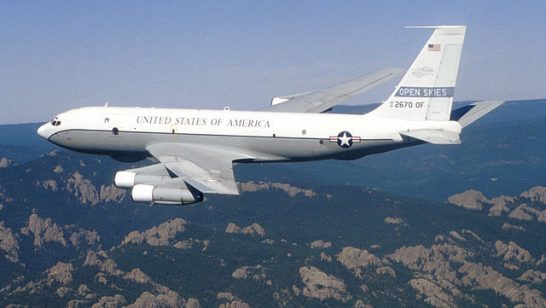
LAST UPDATED: 27 May 2020
Overview
Yesterday morning, rumours that the United States would be imminently withdrawing from the Open Skies Treaty (OST) were confirmed by the United States government and its dismayed European allies who are part of the Treaty. US Secretary of State Michael Pompeo noted through a press statement that a formal notice would be submitted today (22 May 2020):
“Tomorrow, the United States will submit notice of its decision to withdraw from the Treaty on Open Skies to the Treaty Depositaries and to all other States Parties to the Treaty. Effective six months from tomorrow [Added note: 22 November 2020], the United States will no longer be a party to the Treaty. We may, however, reconsider our withdrawal should Russia return to full compliance with the Treaty.”
In turn, the Russian Ministry of Foreign Affairs received an official note from the US Embassy in Moscow. The official response included:
“We are open to dialogue but it must be equitable and be aimed at considering each other’s interests and concerns. However, Washington is not motivated by this approach; it would rather just withdraw from the treaty. This is cause for deep regret because it will result in significant damage to European security. US security concerns will not improve either and its international prestige is bound to be hurt. The policy to discard the Open Skies Treaty calls into question Washington’s negotiability and consistency. This is a source of serious concern even for US allies.
Russian policy on the treaty will be based on its national security interests and in close cooperation with its allies and partners.”
Reactions from Russian officials included:
- Russian Deputy Foreign Minister Alexander Grushko: “Russia will remain committed to its rights and obligations within the Open Skies Treaty, as long other [remaining] parties are fulfilling their obligations in good faith… Russia has not violated the Treaty and nothing prevents the continuation of talks on technical issues that the US says are violations by the Russian side.”
- Russian Deputy Foreign Minister Sergei Ryabkov: “If Russia does not fulfil a number of US demands, the US will withdraw from the Open Skies Treaty in November. US demands make no sense, but Russia is ready to continue dialogue. Russia remains committed, but the US is a serious violator of the Treaty. The concept is similar to what the US did with the Intermediate-Range Nuclear Forces Treaty [INF] Treaty: US aggressively implemented myths in the global policy circles… Media in ‘like-minded nations’ use the same vocabulary for the same myths. Notes received by all OST states-parties, and now Canada and Hungary should gather a conference. There might be different options. [Again,] the US attitude is like with the INF – ‘do this, do that, then we might re-consider’ – but if the US wants to find solutions, they have to address Russian concerns... OST is not dead! When the US withdraws in November, it does not mean that the Treaty will die. The US said that it is a decision, not an intention, so then we will have 33 parties – or less – but it still doesn’t mean OST death. If Europeans are interested, and OST is an important part of European security, we can find solutions. But if some European country will express their ‘deepest concern’ with Russian ‘violations’, that’s not a way forward.” [Note: Translation by Dmitry Stefanovich]
- Russian Permanent Representative to International Organizations in Vienna Mikhail Ulyanov: “No surprise. US allergy nowadays to legally binding arms control treaties is well known. This step will further spoil [the] atmosphere in international relations and can result in less transparency and greater mistrust in [the] Euro-Atlantic region. Regrettable.”
The Russian Ministry of Foreign Affairs also released a series of Q&A to justify the 500km sub-limit in Kaliningrad, including the following PPTX slides:
NATO ambassadors met to consider the implications of US withdrawal from the OST, and NATO Secretary-General Jens Stoltenberg released a statement noting:
“NATO Allies met today to discuss the Open Skies Treaty. We are firmly committed to the preservation of effective international arms control, disarmament, and non-proliferation. We all agree that all states party to the Open Skies Treaty must fully implement their commitments and obligations. All NATO Allies are in full compliance with all provisions of the Treaty.”
In comparison, EU High Representative Josep Borrell noted: “The Open Skies Treaty provides transparency and predictability. It is an important contribution to European an global security… Withdrawing from a Treaty is not the solution to address difficulties in its implementation and compliance by another party”.
In addition, a joint statement by the 10 Foreign Ministries of Belgium, Czech Republic, Finland, France, Germany, Italy, Luxemburg, Netherlands, Spain and Sweden (later joined also by Portugal) noted:
“We regret the announcement by the US Government of its intention to withdraw from the Open Skies Treaty, although we share their concerns about implementation of the Treaty clauses by Russia. … We will continue to implement the Open Skies Treaty, which has a clear added value for our conventional arms control architecture and cooperative security. We reaffirm that this treaty remains functioning and useful. The withdrawal becomes effective within six months.”
The Foreign Ministry of Poland also issued a statement.
American and Russian compliance concerns
The primary three concerns that the United States has over Russian compliance with the OST were stated earlier this year in a wider annual compliance report:
“In 2019, the United States continued to assess that Russia was in violation of the Treaty on Open Skies (OST) in two respects, and also assessed one new violation. Specifically, in 2019, Russia was in violation of the treaty in the following respects:
(1) Section III of Annex A to the Treaty and Open Skies Consultative Commission (OSCC) Decision 3/04 for imposing and enforcing a sublimit of 500 kilometers over the Kaliningrad Oblast for all flights originating out of Kubinka Open Skies Airfield;
(2) Article VI of the Treaty for refusing access to observation flights within a 10 kilometer corridor along Russia’s border with the Georgian regions of South Ossetia and Abkhazia;
(3) Article VI of the Treaty for improperly denying a planned U.S.-Canadian flight segment over Russia’s TSENTR 2019 military exercise on September 20, 2019.”
In response, the Russian government has also outlined five concerns over American compliance with the OST:
“(1) In 2016, the US failed to ensure the safe arrival of the Russian An-30B observation aircraft at the point of entry/exit, by refusing to provide the required number of intermediate airfields. The US position has not changed as of yet. This constitutes a violation of the Treaty on Open Skies by the United States.
(2) In 2017, the night-time rest stops for observation aircraft crews at the refuelling airfields Robins and Ellsworth were cancelled. This violates the observing Party’s right to conduct observation flights of the established maximum flight distance, taking into account the norms of the crew’s workload limits, which directly affects the flight safety.
(3) In violation of the Treaty the United States established the maximum flight distance over the Hawaiian Islands from the Hickam refuelling airfield. However, according to the OST, the maximum flight distance is established only from Open Skies airfields and is calculated by specific rules. The distance limit of 900 kilometres established by the U.S. contrary to the provisions of the OST does not comply with the Treaty in any case as this distance must be at least 1,160 kilometres, if calculated correctly.
(4) The United States imposed restrictions on observation flights over the Aleutian Islands, according to which the aircraft of an observing Party always has to remain within the outer border of the adjacent zone, spanning 24 nautical miles from the coast. This restriction, which is not provided for by the Treaty, significantly reduces the effectiveness of the observation flights.
(5) The United States imposes restrictions on the altitude of the observation aircraft flights over its territory, which are not provided for by the OST and run contrary to the ICAO norms recommending the allocation of a safe airspace for the military aircraft flights.”
Looming questions over US withdrawal legality
In the United States, multiple experts and officials have started to raise the alarm that US President Donald Trump’s withdrawal from the Open Skies Treaty may not be considered legal if escalated to federal courts:
“Section 1234 of the National Defense Authorization Act for Fiscal Year 2020, which became public law No. 116-92 on December 20, 2019, states that, at least 120 days before submitting the intent to withdraw the United States from the Open Skies Treaty to one of the two Treaty depositories, the Secretary of State and Secretary of Defense must submit a notification to Congress that: (1) withdrawal from the Treaty is in the national security interest of the United States and (2) that other state parties to the Treaty have been consulted. If, as has been reported, the Administration submits its intent to withdraw to the Treaty depository, it will have violated this law. No such notification has been submitted to Congress as of May 21, 2020.“
Other American lawmakers also noted that multiple communications from the House Armed Services Committee and other congressional chairmen have gone unanswered. They write that the US withdrawal is “a slap in the face to [US] allies in Europe, leaves [American] deployed forces in the region at risk, and is in blatant violation of the law”.
However, President Trump has made it clear that he believes he has the authority to withdraw from the OST without answering to Congress, and it is unclear to what extent there is an appetite amongst US legislators to collectively take a stand.
What to do next?
Earlier this month, the ELN released a high-level statement on the pending US withdrawal from the OST, outlining ways that the US and Russia could deal with their concerns through the Treaty and, if all else failed and the US withdrew, what remaining States Parties should do. The signatories noted:
“Should the United States withdraw from the Open Skies Treaty, remaining State Parties must make a determined effort to consider its effect on the treaty. According to Article XV.3 of the treaty, if the United States withdraws, Canada and Hungary must convene a conference of the States Parties no less than 30 days and no more than 60 days after they have received a withdrawal notice. Parties should adopt a position of maximum flexibility. We recommend that:
(1) State parties should make every effort to hold this conference in a timely fashion, by considering holding the conference tele-remotely. If this is considered unworkable, the conference should be held as soon as conditions will allow;
(2) Remaining state parties should also satisfactorily address concerns that NATO member states could share data from overflights with the United States after it left the treaty.
(3) Remaining parties should maintain maximum flexibility to constructively address reallocation of quotas and the lifting of flight restrictions.”
European officials must directly encourage the United States administration to engage in good-faith discussions with Russia on mutual compliance concerns. Simultaneously, as ELN senior network members recently wrote, Europeans should make every effort to find ways to remain in the Treaty alongside Russia even if the US inevitably withdraws. This will require Europeans to have a frank, open dialogue with Russia on how US withdrawal will affect the OST regime to pragmatically identify what opportunities for continued cooperation could still exist under the agreement without US participation.
While the US political system has a chance to react to this latest development, the long-standing, outstandingly positive European sentiment towards the Open Skies Treaty must be loudly voiced. Even if the six-month clock until final US withdrawal has started in the eyes of the US administration, the coming weeks will be crucial if any momentum is to be gained amongst the US Congress to press for a meaningful resolution to the aforementioned compliance issues.
To learn more about the Open Skies Treaty, please visit www.openskies.flights (also available in Russian).








